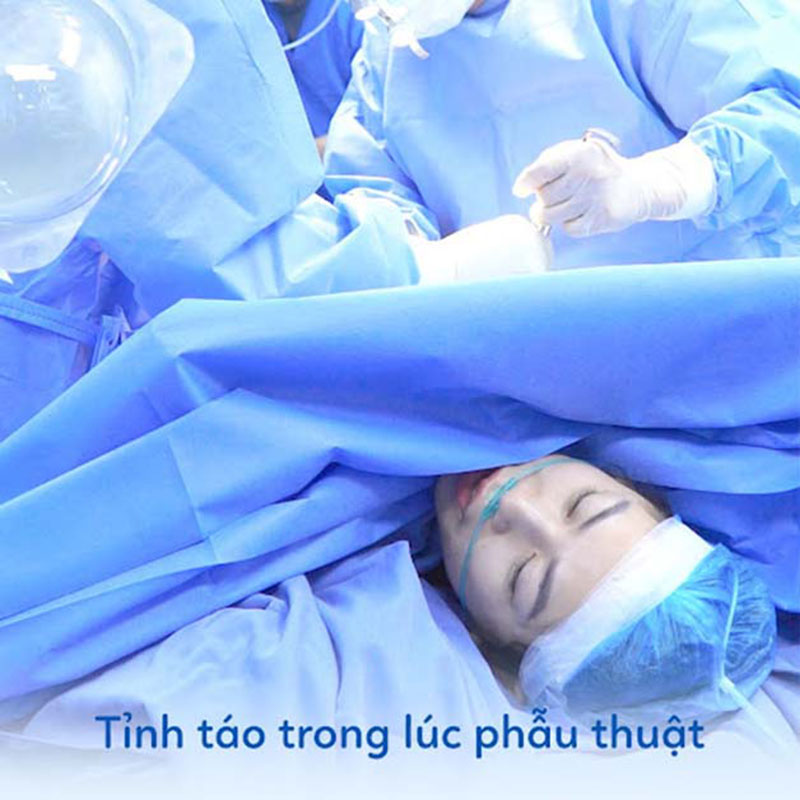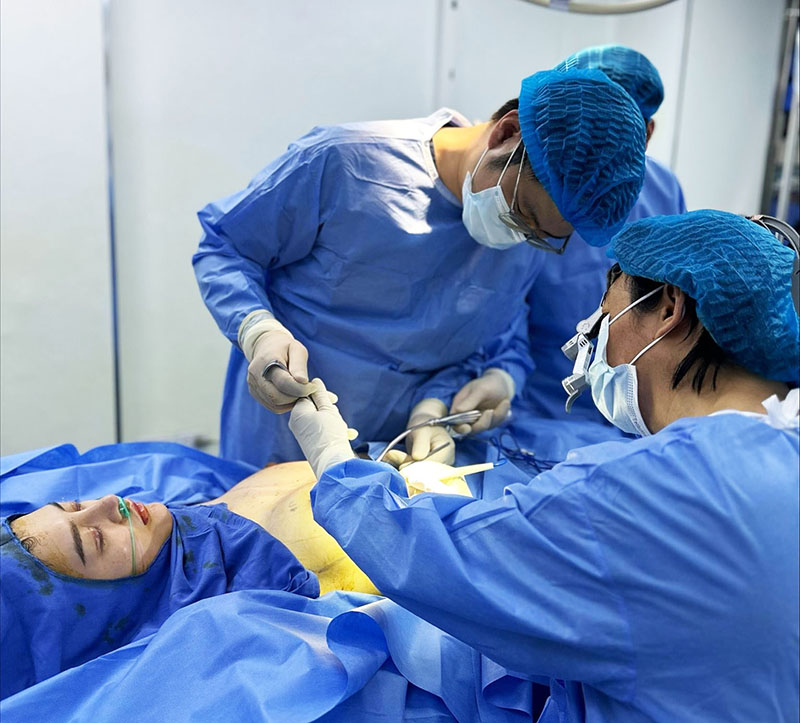Date posted: 28-10-2024 | Last updated : 04-11-2024

Breast augmentation has become a popular beauty trend, helping women achieve fuller, more attractive breasts, boosting their confidence and improving their quality of life. Join Dr. Richard Huy, a leading expert in body contouring cosmetic surgery, to explore the secrets to achieving the ideal breast size and shape.
Breast augmentation is a cosmetic surgical procedure designed to enhance the shape and size of the breasts by inserting implants beneath the breast tissue or chest muscles. This procedure helps women achieve fuller, more balanced, and attractive breasts.

Breast Augmentation is a Method to Enhance the Shape and Size of the Breasts
Breast augmentation not only increases the size and fullness of the breasts but also addresses issues like sagging, uneven breasts, or deformities caused by childbirth, weight loss, or medical conditions.
The surgery typically takes a few hours, and patients need a recovery period of 2-4 weeks, depending on their individual condition and how well they follow post-operative care instructions.
Breast augmentation is a major surgery and should be carefully considered based on various factors. Below are some cases where breast augmentation may be a suitable option:

Individuals with Small, Flat Breasts Should Consider Breast Augmentation
Before deciding on breast augmentation, it is important to thoroughly research the procedure, including the methods, costs, and recovery time. Additionally, choosing a reputable surgeon and medical facility is crucial to ensure the surgery is successful and delivers the desired results.
There are four main incision options for breast augmentation: around the areola, through the armpit, at the breast fold, and via the navel. Each incision method has its own advantages and disadvantages, and the choice of which one to use depends on the patient’s preferences and the surgeon’s recommendations.

Three Common Breast Augmentation Incision Methods
The areola incision is a popular method in which the surgeon makes a small cut around the areola, creating a pocket under the breast tissue and inserting the implant.
- Advantages:
- Disadvantages:
The armpit incision involves making a small cut in the armpit, through which the surgeon uses endoscopic tools to create a space under the breast tissue and insert the implant.
- Advantages:
- Disadvantages:
According to Dr. Richard Huy, the inframammary fold incision is the most traditional and widely used method. The incision is made along the natural fold under the breast where it meets the torso, a discreet location that effectively hides the scar.
- Advantages:
- Disadvantages:
The umbilical incision is a unique breast augmentation technique where the incision is made at the belly button. However, it is less common than other methods, such as the armpit, inframammary fold, or areola incisions, due to the increased risk of infection, bleeding, and other complications when creating the space and inserting the implant through the belly button.
- Advantages:
- Disadvantages:
The "Light as air” breast augmentation is a groundbreaking approach in breast enhancement, exclusively developed by Dr. Richard Huy and his team of experts at Kangnam Aesthetic Hospital. It provides a modern, gentle, and comfortable experience for patients.
"Light as air" breast augmentation is an advanced cosmetic technique that uses a "multimodal anesthesia" method, where anesthesia is administered intravenously to minimize pain and create a comfortable state for the patient throughout the procedure. With this method, patients remain awake and can communicate with the surgeon during the surgery. Additionally, they can be discharged on the same day without the need for an overnight stay.

"Light as Air" Breast Augmentation: A Breakthrough in Breast Aesthetic Surgery
With the application of "multimodal anesthesia," the "Light as Air" breast augmentation technique offers numerous benefits, including pain-free surgery, patient alertness during the procedure, overcoming the drawbacks of traditional general anesthesia, three times faster recovery, and the creation of full, natural-looking breasts.
A unique aspect of this technique is its ability to keep patients fully awake during the surgery. Patients can comfortably converse with the surgeon and monitor the breast augmentation process without feeling drowsy or foggy. This provides a safe and controlled breast augmentation experience.

Clients are awake during the breast augmentation procedure, “Light as air”
Dr. Richard Huy further explains that traditional anesthesia often comes with side effects such as nausea, dizziness, and fatigue after surgery. However, with the “Light as Air” method, these side effects are significantly reduced. Clients feel more alert and comfortable right after surgery, making the recovery process much easier.
Thanks to advanced techniques and the minimized impact of anesthesia, the recovery time after the “Light as Air” breast augmentation is three times faster than traditional methods. Clients can return home the same day without needing to stay overnight at the hospital.
The “Light as Air” breast augmentation method focuses not only on comfort and safety during surgery but also on delivering optimal aesthetic results. After the procedure, the breasts will be full, round, and soft, allowing clients to feel confident with their new body shape while maintaining a natural look.

Hot tiktoker Chi Doi and Fansie have plump, attractive busts after breast augmentation "As light as air"
Below is the detailed breast augmentation procedure performed by Dr. Richard Huy:
Step 1: Consultation and selecting the appropriate breast augmentation method
The doctor will listen to the client’s desires and requirements regarding the desired shape and size of their breasts. The doctor will then conduct an examination, assess the current condition of the breasts, and consider factors such as skin type, breast tissue, and other factors like body type, age, and health to recommend the most suitable breast augmentation method.
Step 2: Health check
Before surgery, the client will be required to undergo necessary medical tests to ensure they are healthy enough for the procedure. These tests include blood work, chest X-rays, and other tests as advised by the doctor. The purpose is to ensure absolute safety throughout the surgery and recovery process.
Step 3: Pre-surgery marking
The doctor will proceed with marking the body directly on the client to determine the precise incision location and the placement of the breast implants. This step is crucial to ensure that the result will be as natural and balanced as possible, in harmony with each individual’s body.I
Step 4: Anesthesia
The client will be administered anesthesia using the "multimodal anesthesia" method. The anesthetic is injected intravenously, ensuring the client feels no pain during the surgery while remaining awake and comfortable.
Step 5: Surgery
The doctor will perform the surgery according to the pre-discussed plan. Depending on the selected method, the doctor will make an incision at the marked location, insert the breast implant into the proper position, and adjust it for optimal aesthetic results. Finally, the doctor will meticulously stitch the incision to minimize scarring and expedite recovery.

The surgeon performed the surgery according to a previously discussed plan.
Step 6: Post-operative care
After the surgery is completed, the client will be moved to a recovery room for rest and observation. The doctor and medical team will guide the client on how to care for the incision, manage pain, and advice on precautions to take during the recovery period.
The client will be prescribed medication to reduce pain and prevent infection. Post-operative care will be closely monitored to ensure the best results and avoid potential complications.
Step 7: Follow-up appointment
The doctor will schedule a follow-up appointment to check on the recovery progress and evaluate the surgical outcome. During these check-ups, the doctor will examine the incision, implant position, and client satisfaction. Additionally, the doctor will continue providing advice and instructions on how to care for the breasts post-surgery to maintain long-lasting results.
With the advancement of cosmetic medicine, breast augmentation techniques have become increasingly refined, ensuring safety and minimizing risks. However, it is essential to consider the procedure carefully as it can still pose some risks, such as infection, bleeding, fluid accumulation, capsular contracture, or implant rupture. Therefore, clients should seek out reputable cosmetic clinics for thorough consultation and examination before deciding on breast augmentation.
Breast augmentation does not cause a loss of sensation in the breast area when performed correctly by an experienced surgeon. Modern techniques, such as incisions through the areola, under the breast fold, or through the armpit, are designed to minimize the impact on important sensory nerves in the breast. The surgeon will carefully avoid damaging the nerves when creating the pocket for the implant.
Additionally, placing the implant under the breast tissue or beneath the chest muscle affects the sensory nerves less, helping to preserve breast sensation.
The answer is "yes." Breast augmentation does not interfere with the ability to breastfeed, as implants placed under the chest muscle do not come into contact with milk glands or ducts, minimizing the risk of damage to the structures necessary for breastfeeding. The surgeon will take extra care during the procedure to avoid injuring the milk ducts and glands, allowing women to maintain their ability to breastfeed.
Breast augmentation is not just about changing your body shape but also about helping women feel more confident, attractive, and beautiful. If you have any more questions about breast augmentation, feel free to leave a comment below, and Dr. Richard Huy will respond as soon as possible.